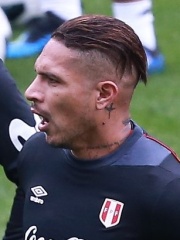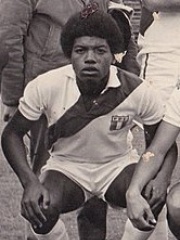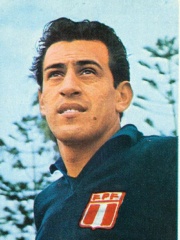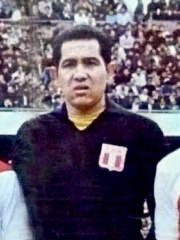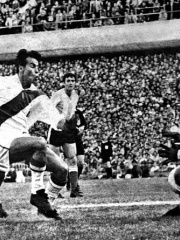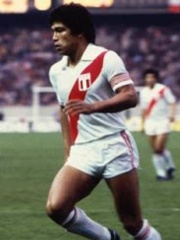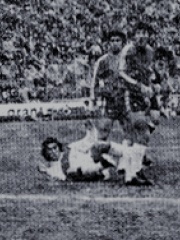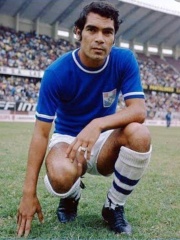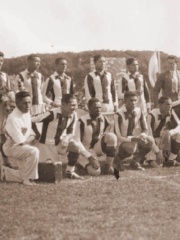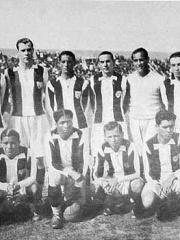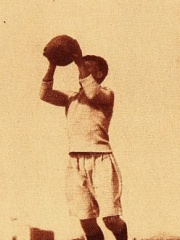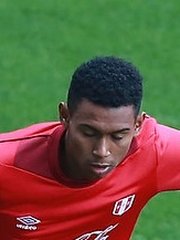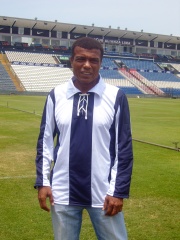
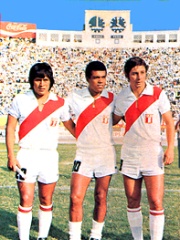
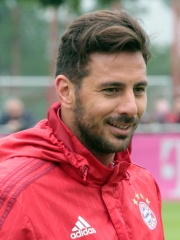
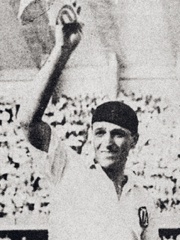

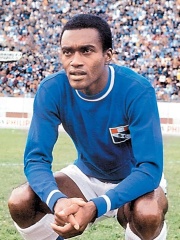
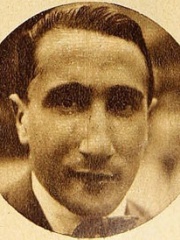
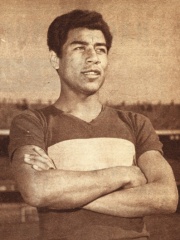
The Most Famous
SOCCER PLAYERS from Peru
This page contains a list of the greatest Peruvian Soccer Players. The pantheon dataset contains 21,273 Soccer Players, 130 of which were born in Peru. This makes Peru the birth place of the 38th most number of Soccer Players behind Slovakia, and Ghana.
Top 10
The following people are considered by Pantheon to be the top 10 most legendary Peruvian Soccer Players of all time. This list of famous Peruvian Soccer Players is sorted by HPI (Historical Popularity Index), a metric that aggregates information on a biography's online popularity. Visit the rankings page to view the entire list of Peruvian Soccer Players.

1. Teófilo Cubillas (b. 1949)
With an HPI of 67.77, Teófilo Cubillas is the most famous Peruvian Soccer Player. His biography has been translated into 44 different languages on wikipedia.
Teófilo Juan Cubillas Arizaga (Spanish pronunciation: [teˈofilo kuˈβiʎas]; born 8 March 1949) is a Peruvian former footballer who played as an attacking midfielder. He is considered Peru's greatest ever player and one of the best in the history of South America. In an IFFHS poll he was selected as the best Peruvian player in history and was also included in the world's Top 50 of the 20th century. At the 1970 FIFA World Cup, Pelé acknowledged Cubillas, referring to him as his successor. Cubillas was renowned for his technique, shooting ability and free kick ability. Beginning at Alianza Lima, he was nicknamed El Nene (The Kid), and was part of the Peru national team that won the 1975 Copa América. He helped Peru reach the quarter finals at the 1970 FIFA World Cup and again at the 1978 World Cup, along with qualifying for the 1982 World Cup. He was elected the South American Footballer of the Year in 1972. At a club level, he is the second all time highest goalscorer of Alianza Lima with 165 and the top goalscorer of the Fort Lauderdale Strikers with 65. For the national team, he is the third all time goalscorer with 26 goals in 81 appearances. He is also the joint 10th all time goalscorer of the FIFA World Cup with 10 goals in 13 matches. In 2004, Pelé selected Cubillas as one of the FIFA 100, a list of 125 footballing greats. In February 2008, to celebrate the 50th anniversary of the first Brazilian World Cup victory, he was selected in the All-Star First Team of South America of the past 50 years. Cubillas is one of only three players to score five or more goals in two different World Cups, the other two being Miroslav Klose and Thomas Müller. His free-kick against Scotland in 1978 is renowned as one of the best goals scored at the World Cup.

2. Hugo Sotil (1949 - 2024)
With an HPI of 63.30, Hugo Sotil is the 2nd most famous Peruvian Soccer Player. His biography has been translated into 27 different languages.
Hugo Alejandro Sotil Yerén (18 May 1949 – 30 December 2024) was a Peruvian professional footballer. Nicknamed El Cholo, he played as a striker or midfielder. Together with Teófilo Cubillas and Héctor Chumpitaz, he was one of Peru's most recognized football players of the 1970s. He also was a popular player in Peru, and a biopic on his life was released in that decade. He was a member of the Peru national team that won the 1975 Copa América and reached the quarterfinals in Mexico 1970 and Argentina 1978. Sotil made his professional debut in 1967, standing out with Deportivo Municipal and became one of the most popular players in Peru. In 1973 he gained international fame by signing for FC Barcelona forming a historic attacking duo with the Dutch star Johan Cruyff winning the Spanish Primera División in his first season after 14 years of drought for the Catalan club. He became the first Latin American player to wear the "10" for FC Barcelona. Carrying the number 10 on his back in addition to getting two league runners-up and one in the Copa del Rey after four seasons with the Barça shirt. In 1977 he returned to Peru and became two-time national champion with Alianza Lima in 1977 and 1978. In 1973 he joined the starting team of the America national team that faced the Europe team of Johan Cruyff, Eusébio and Giacinto Facchetti. The match ended 4–4, and Sotil scored the third goal for his team, then in a penalty shootout the American team won 7–6. That night he played alongside other South American figures such as Rivellino, Fernando Morena, Miguel Brindisi, Víctor Espárrago, Teófilo Cubillas and others. He was international with the Peruvian team, with which he played two editions of the FIFA World Cup: those of 1970 and 1978, where he reached the quarterfinals in both World Cups. On a continental level, he won the Copa América in 1975, where he scored the only goal of the final match against Colombia, giving the Inca team the title of Champions of America. Sotil has been one of the most popular athletes in his country, to the point that in 1972, he starred in a film directed by Bernardo Batievsky (his great admirer) entitled Cholo.

3. Claudio Pizarro (b. 1978)
With an HPI of 61.58, Claudio Pizarro is the 3rd most famous Peruvian Soccer Player. His biography has been translated into 54 different languages.
Claudio Miguel Pizarro Bosio (Latin American Spanish: [ˈklawðjo piˈsaro]; born 3 October 1978) is a Peruvian former professional footballer who played as a striker. He is currently serving as club ambassador for Bayern Munich. He was captain of Peru's national football team, being its fifth highest scorer. He is the highest scorer and most successful Latin American football player in the history of German football. He is the all-time top scorer of SV Werder Bremen, the ninth top scorer in the history of Bayern Munich and the sixth top scorer in the history of the Bundesliga and its second top scorer in the 21st century. He is also among the 20 top scorers in the history of UEFA club competitions and is the seventh highest South American scorer in European football history. His professional debut came in 1996, with Deportivo Pesquero. In 1998, he joined Alianza Lima, where he won a Peruvian Primera División, being highlighted as the best player of the season. In 1999, he was signed by Werder Bremen from the Bundesliga. Just one year later, he was chosen as the newcomer player of the championship and was included in the ideal team of the 2000–01 season. In 2001, he signed for Bayern Munich and the following seasons he won one Intercontinental Cup, 2 Bundesligas, 4 DFB-Pokale (German Cups), 2 DFL-Ligapokale (German League Cups) and the DFL-Supercup (German Super Cup). In addition, he was the top scorer in the DFB-Pokal in the 2004–05 and 2005–06 editions. In 2007, he signed for Chelsea F.C. scoring on his debut and achieving runner-up in the Premier League at the end of the season. In 2009, he returned to Bremen, where he was champion of the 2008–09 DFB-Pokal and the unofficial 2009 German Supercup, in addition to becoming top scorer in the 2009–10 UEFA Europa League. In 2012, he was hired again by Bayern Munich, winning the UEFA Champions League, the Club World Cup, the European Super Cup, the DFL-Supercup, three Bundesligas and two DFB-Pokale, thus becoming the foreign player with most titles in the history of Bayern Munich, a total of 18. In mid-2015, he returned to Werder Bremen. In 2017, he was hired by the 1. FC Köln, from which he separated a year later to return to Werder Bremen. Pizarro is the Peruvian football player with the most goals scored and games played in Europe and in German football. He is the second highest foreign scorer and sixth all-time historic scorer in the Bundesliga (197 goals). He is also the Latin American football player with the most goals scored and titles won in the history of German football. He is the ninth all-time top scorer for the DFB-Pokal (34 goals), top scorer for Werder Bremen (153 goals), the ninth all-time top scorer for Bayern Munich (125 goals), the tenth historical scorer of the UEFA Europa League (24 goals) and the fifth historical scorer of Peru's national football team (20 goals). He is also the foreign player with the most games played in the history of Bundesliga and the DFB-Pokal. Pizarro is considered an idol by Bayern Munich's fans and a legend of Werder Bremen's, teams for which he scored more than 100 goals each. As well as being one of the players with the most seasons played in the history of the German league, Pizarro is also the oldest player to score a goal in the Bundesliga (at over 40 years old). In international competitions, he is the fourth highest Latin American scorer in European Cups (Champions League, UEFA Cup and UEFA Europa League) with 48 goals, ranking only behind Lionel Messi, Alfredo Di Stéfano and Sergio Agüero. With the Peru national football team he is the fifth highest scorer with 20 goals and the tenth with the most matches (85). With the senior team, he achieved the third place at the 2015 Copa América. He also participated in the 2004 and 2007 Copa América.

4. Teodoro Fernández (1913 - 1996)
With an HPI of 58.85, Teodoro Fernández is the 4th most famous Peruvian Soccer Player. His biography has been translated into 28 different languages.
Teodoro "Lolo" Fernández Meyzán (20 May 1913 – 17 September 1996) was a Peruvian professional footballer who played as forward. All his football work was carried out as a player of the Universitario de Deportes of the Peruvian First Division. He was champion, best player and top scorer in the 1939 Copa América. He is the top idol of Universitario de Deportes and Peruvian First Division. Fernández is the most emblematic player in the history of club Universitario de Deportes for which he played his whole career, winning six times the Primera División Peruana. Although he sporadically reinforced other clubs in friendly matches, clubs such as Alianza Lima and Colo-Colo, Fernández never represented a club other than Universitario in official competitions. Known as "El Cañonero" ("The Cannoneer") due to his excellence as a centre-forward and his strong shooting, Fernández was the Primera División Peruana top-scorer seven times.
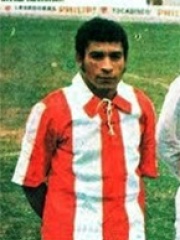
5. Héctor Chumpitaz (b. 1943)
With an HPI of 58.06, Héctor Chumpitaz is the 5th most famous Peruvian Soccer Player. His biography has been translated into 20 different languages.
Héctor Eduardo Chumpitaz González (Latin American Spanish: [ˈeɣtoɾ ˈtʃumpitas]; born 12 April 1943, in Cañete) is a former footballer from Peru. He was voted one of the greatest defenders of all time, among the 30 best defenders in football history, and included within the 100 best players in the history of the World Cup by FIFA in 2018. He is also a member of the Historic Ideal Team of Copa América by CONMEBOL. In addition, he is the seventh highest-scoring South American defender in football history, with 65 official goals. Considered by FIFA as one of the best South American defenders of all time, Chumpitaz is also one of the greatest exponents in the history of Peruvian football. He spent most of his career at Universitario de Deportes and Sporting Cristal. He currently has a football school named as him, where he is dedicated to training minors. Chumpitaz was regarded one of the best defenders in the world during the late 1960s and early 1970s, and is widely considered one of the four best South American defenders of all time along with Elías Figueroa, José Nasazzi, and Daniel Passarella. With great defensive skills, excellent reading of the game, possession and distribution of the ball and an imposing leader role, he became one of the most legendary figures of Universitario de Deportes, a club with which he won five titles in the Peruvian League and was a finalist in the Copa Libertadores in 1972. In addition to having won three other national titles with Sporting Cristal, Chumpitaz is remembered for having been captain of the American team that played a friendly match against the stars of Europe, among them were Giacinto Facchetti, Eusébio da Silva Ferreira, Johan Cruyff —who was the captain of Europe, among other figures. It was there that he was given the nickname "El Capitán de America" ("Captain America"). At the national team level, for almost fifteen years Chumpitaz was the captain and great defensive bulwark of the Peru national football team that won the Copa América 1975 and reached the quarterfinals in the FIFA World Cup of Mexico 1970 and Argentina 1978. Chumpitaz is considered one of the greatest South American defenders of all-time and was named to the list of best World Cup players of all time by Terra.com in 2006. He was elected the 35th best South American footballer of the 20th century in a poll by the IFFHS in 2000.

6. Plácido Galindo (1906 - 1988)
With an HPI of 57.09, Plácido Galindo is the 6th most famous Peruvian Soccer Player. His biography has been translated into 21 different languages.
Plácido Reynaldo Galindo Pando (9 March 1906 – 22 October 1988) was a Peruvian football midfielder who played for Peru in the 1930 FIFA World Cup, where he also became the first ever player sent off in a World Cup match. He also was a player, manager and president of Universitario de Deportes.

7. Alberto Gallardo (1940 - 2001)
With an HPI of 56.20, Alberto Gallardo is the 7th most famous Peruvian Soccer Player. His biography has been translated into 18 different languages.
Félix Alberto Gallardo Mendoza (28 November 1940 – 19 January 2001) was a Peruvian football player and manager who played as a forward. He is regarded as a renowned sprinter, possessing shooting power and an atypical physical display for Peruvian football. For years he was a renowned left wing of Sporting Cristal and the National Peruvian Team from where he launched strong shots with either of the two profiles. Because of his style of play, he was popularly known as the "Jet". He is considered one of the best Peruvian wingers of all time. He began his career with Club Mariscal Castilla but the Bentín family, founder of Sporting Cristal, signed him for the sky-blue team and his decision resulted in the consecration of the best player in the history of the Rimense club. Gallardo played 14 seasons with Sporting Cristal, scoring 148 goals in 261 games, won the Peruvian Primera División four times and became the top scorer twice in the championship. In 1963, he stood out in the Copa América by scoring four goals and, for the following season, joined AC Milan which was the current European champion at that time. Within the team, he had little continuity and shortly after he was loaned to Cagliari Calcio where he had some regularity. In 1966, he decided to go to Brazil and joined Palmeiras. There he had his best performance abroad, managing to be a two-time Brasileirao champion as well as winning the 1966 Campeonato Paulista. During the 1970 FIFA World Cup, he scored two goals one against Bulgaria in the group stage, and another against Brazil in the quarterfinals. In addition to Teófilo Cubillas, the top Peruvian scorer in the World Cups, is the only Peruvian player to have scored more than one goal in the history of Peruvian participation in the World Cups. He is considered the greatest idol of Sporting Cristal where he won five national championships with one of them as the technical director. He is also recognized for his great work in the lower divisions of the club, to which he dedicated a large part of his life until the day of his death. Within the Peruvian national team, he played 37 games in which he scored 11 goals, participated in the 1960 Summer Olympics, the 1963 South American Championship and the 1970 FIFA World Cup.

8. Mario de las Casas (1905 - 2002)
With an HPI of 56.12, Mario de las Casas is the 8th most famous Peruvian Soccer Player. His biography has been translated into 20 different languages.
Mario de las Casas Ramírez (31 January 1901 – 10 October 2002) was a Peruvian football defender who played for Peru in the 1930 FIFA World Cup and the 1935 Campeonato Sudamericano.

9. Víctor Benítez (1935 - 2022)
With an HPI of 56.06, Víctor Benítez is the 9th most famous Peruvian Soccer Player. His biography has been translated into 17 different languages.
Víctor Benítez Morales (12 September 1935 – 11 July 2022) was a Peruvian professional footballer who played as a centre-back or defensive midfielder. Nicknamed "El Conejo", he notably played for Italian clubs AC Milan, Roma and Inter Milan as well as Argentine club Boca Juniors. He won the European Cup title with AC Milan in 1963. Along with José Velásquez, he is recognised as one of Peru's most important defensive midfielders of all time.
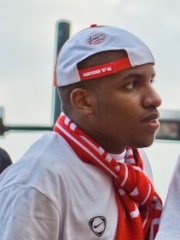
10. Jefferson Farfán (b. 1984)
With an HPI of 55.72, Jefferson Farfán is the 10th most famous Peruvian Soccer Player. His biography has been translated into 43 different languages.
Jefferson Agustín Farfán Guadalupe (Spanish pronunciation: [ˈɟʝefeɾsoɱ faɾˈfan]; born 26 October 1984) is a Peruvian former professional footballer who mainly played as a winger. Commonly known as Farfán or the nickname Foquita (Spanish for Little Seal), he is known for his speed and technical ability and was one of the best providers of assists during his time in the Bundesliga. Farfán began his career with Deportivo Municipal and Alianza Lima; the latter club saw him make his professional debut in 2001. In 2002, Farfán was highlighted as one of the next best players of Peruvian football and a year later, won his second Primera División title. After winning his third league title with Alianza in 2004, he was recognized as the best Peruvian player of that year. Having joined PSV Eindhoven in mid-2004, Farfán helped the Dutch giants win four Eredivisie titles. He signed for Bundesliga side Schalke 04 in 2008 and during his time with the club, he won the 2011 DFB-Pokal Final. In 2012, he was named the most expensive Latin American player in the league. Farfán briefly played for Al-Jazira in the United Arab Emirates before leaving due to a breach of contract. He last played in Russia for Lokomotiv, when, in his second season, helped the club win their first league title in 14 years and finished as the team's top scorer. With the national team, Farfán is the country's second top goalscorer, behind only Paolo Guerrero. He is very popular in Peru, with coach Ricardo Gareca naming him "one of the most important players in the history of Peruvian football." He helped his side finish third at the 2015 Copa América and second in Brazil 2019.
People
Pantheon has 130 people classified as Peruvian soccer players born between 1900 and 2003. Of these 130, 86 (66.15%) of them are still alive today. The most famous living Peruvian soccer players include Teófilo Cubillas, Claudio Pizarro, and Héctor Chumpitaz. The most famous deceased Peruvian soccer players include Hugo Sotil, Teodoro Fernández, and Plácido Galindo. As of April 2024, 8 new Peruvian soccer players have been added to Pantheon including Franco Navarro, Miguel Miranda, and Marcos López.
Living Peruvian Soccer Players
Go to all RankingsTeófilo Cubillas
1949 - Present
HPI: 67.77
Claudio Pizarro
1978 - Present
HPI: 61.58
Héctor Chumpitaz
1943 - Present
HPI: 58.06
Jefferson Farfán
1984 - Present
HPI: 55.72
Paolo Guerrero
1984 - Present
HPI: 54.83
Gerónimo Barbadillo
1954 - Present
HPI: 53.16
Rubén Correa
1941 - Present
HPI: 53.10
Luis Rubiños
1940 - Present
HPI: 51.72
César Cueto
1952 - Present
HPI: 51.62
Oswaldo Ramírez
1947 - Present
HPI: 51.50
Rubén Toribio Díaz
1952 - Present
HPI: 51.41
Juan Carlos Oblitas
1951 - Present
HPI: 51.36
Deceased Peruvian Soccer Players
Go to all RankingsHugo Sotil
1949 - 2024
HPI: 63.30
Teodoro Fernández
1913 - 1996
HPI: 58.85
Plácido Galindo
1906 - 1988
HPI: 57.09
Alberto Gallardo
1940 - 2001
HPI: 56.20
Mario de las Casas
1905 - 2002
HPI: 56.12
Víctor Benítez
1935 - 2022
HPI: 56.06
Luis de Souza Ferreira
1908 - 2008
HPI: 55.56
Orlando de la Torre
1943 - 2022
HPI: 55.28
Antonio Maquilón
1902 - 1984
HPI: 55.20
Eduardo Astengo
1909 - 1979
HPI: 55.12
Alberto Denegri
1906 - 1973
HPI: 55.04
Jorge Pardon
1905 - 1977
HPI: 55.02
Newly Added Peruvian Soccer Players (2025)
Go to all RankingsFranco Navarro
1961 - Present
HPI: 44.87
Miguel Miranda
1966 - 2021
HPI: 42.83
Marcos López
1999 - Present
HPI: 36.71
William Chiroque
1980 - Present
HPI: 34.85
Salomón Libman
1984 - Present
HPI: 34.83
Adán Balbín
1986 - Present
HPI: 34.06
Jair Céspedes
1984 - Present
HPI: 33.46
Irven Ávila
1990 - Present
HPI: 32.29
Overlapping Lives
Which Soccer Players were alive at the same time? This visualization shows the lifespans of the 25 most globally memorable Soccer Players since 1700.

